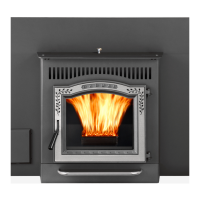13
Save These Instructions 3-90-775R36_09/15
NOTE: The restriction of not venting more than one appliance
tothesameueappliestotheU.S. specically.Whileitisnot
recommended that you use the same chimney for more than
one appliance, in Canadacertainexceptionsmaybemade.
Besuretocontactyourbuildingcodeinspectionofcialto
seeifthisoptionisallowedinyourarea,andtondoutthe
specicrequirementsforsuchaninstallation.
Donotconnectthisunittoachimneyueservicing
another appliance.
B. Avoiding Smoke and Odors
Negative Pressure, Shut-down, and Power Failure:
Toreducetheprobabilityofback-draftingorburn-backin
thepelletburningapplianceduringpowerfailureorshut-
downconditions,thestovemustbeabletodraftnaturally
withoutexhaustbloweroperation.Negativepressureinthe
house will resist this natural draft if not accounted for in the
pellet appliance installation.
Heatrisesinthehouseandleaksoutatupperlevels.This
airmustbereplacedwithcoldairfromoutdoors,whichows
into lower levels of the house. Vents and chimneys into
basements and lower levels of the house can become the
conduit for air supply, and reverse under these conditions.
Outside Air:
Hearth & Home Technologies recommend attaching
outside air in all installations, especially lower level and
mainoorlocations.
Per national building codes, consideration must be given to
combustion air supply to all combustion appliances. Failure
to supply adequate combustion air for all appliance demands,
mayleadtoback-draftingofthoseandotherappliances.
Whentheapplianceisside-wallvented:Theairintakeisbest
locatedonthesameexteriorwallastheexhaustventoutlet
andlocatedloweronthewallthantheexhaustventoutlet.
When the appliance is roof vented:The air intakeis best
locatedontheexteriorwallorientedtowardstheprevailing
wind direction during the heating season.
The outside air connection will supply the demands of the
pellet appliance, but consideration must be given to the
total house demand. House demand may consume some
air needed for the stove, especially during a power failure. It
may be necessary to add additional ventilation to the space in
which the pellet appliance is located. Consult with your local
HVAC professional to determine the ventilation demands for
your house.
The outside air kit consists of a ue stub pipe, berglass
gasket,siliconegasket,intakeboxandasectionofexpipe.
Anadjustablechimneyintakeextension,part#1-00-674104
is available to be used on masonry chimneys only.
Toinstalloutsideair,usekitpartnumber1-00-774280.Follow
theinstallationinstructionsprovidedwiththekit.
VentCongurations:
To reduce probability of reverse drafting during shut-
down conditions, Hearth & Home Technologies strongly
recommends:
• Installing the pellet vent with a minimum vertical run of
vefeet,preferablyterminatingabovetheroofline.
• Installingtheoutsideairintakeatleastfourfeetbelow
the vent termination.
Topreventsootdamagetoexteriorwallsofthehouseand
topreventre-entryofsootorashintothehouse:
• Maintainspeciedclearancestowindows,doors,and
air inlets, including air conditioners.
• Ventsshouldnotbeplacedbelowventilatedsofts.Run
the vent above the roof.
• Avoid venting into alcove locations.
• Ventsshouldnotterminateunderoverhangs,decksor
onto covered porches.
• Maintain minimum clearance of 12" from the vent
termination to the exterior wall. If you see deposits
developingonthewall,youmayneedtoextendthis
distance to accommodate your installation conditions.
Hearth & Home Technologies assumes no responsibility
for, nor does the warranty extend to, smoke damage
causedby reverse draftingofpellet appliancesunder
shut-downorpowerfailureconditions.
Do not connect this unit to any air distribution duct
or system.

